Research Report2015
Transmitting Electromagnetic Waves for Plasma Heating with High Efficiency and High Quality: Numerical Simulation of Electromagnetic Wave Propagation in Waveguides
In the Large Helical Device (LHD) we heat electrons in plasma by using high frequency electromagnetic waves. In the method called electron cyclotron resonance heating (ECH) we inject powerful electromagnetic waves generated by a device called a gyrotron. ...
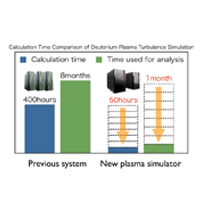
Accelerating fusion research through the cutting edge supercomputer
At the Inter-University Research Institute Corporation National Institutes of Natural Sciences National Institute for Fusion Science, for the first time in the world, using the newly installed "Plasma Simulator" we have simulated deuterium plasma turbulence in the Large Helical Device (LHD). ...
Investigating Plasma’s “Thread-like” Behavior by Computer Simulation: Microscopic Effects in Edge Plasma
Inside a vacuum vessel of a high-temperature plasma experiment device such as the Large Helical Device (LHD), we confine high-temperature high-density plasma by generating a magnetic field container. ...
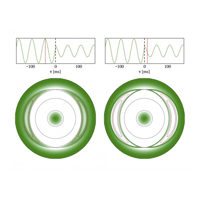
Discovery of a new confinement state for plasma
The National Institutes of Natural Sciences National Institute for Fusion Science applied the "Momentary Heating Propagation Method" to the DIII-D tokamak device operated for the United States Office of Science, Department of Energy, by the General Atomics and made the important discovery of a new plasma confinement state. ...
Enhancing the High Efficiency of Electron Cyclotron Resonance Heating: Estimating How Electromagnetic Waves Curve
In order to realize fusion energy the plasma temperature must be raised to more than 100,000,000 degrees. In the Large Helical Device (LHD), we are conducting research on the confinement of high-temperature plasma in a twisted nested container with magnetic fields that are invisible to the eye and produced by electromagnets. ...
LHD Plasma in Which Impurities Naturally Decrease: Research on Impurity Transport in Edge Plasma
By being confined in a doughnut-type magnetic field container, high-temperature plasma that aims for nuclear fusion power generation does not touch the vacuum vessel. ...
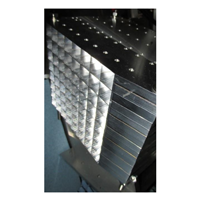
A 2-dimensional microwave camera has been developed
The National Institutes of Natural Sciences National Institute for Fusion Science has developed a high-speed two-dimensional microwave camera for performing diagnostics of high-temperature plasma. ....
Analyzing Big Data at High Speed!: Developing a High-speed Plasma Analysis System
In the LHD, typically one time every three minutes a plasma that lasts for a few seconds is generated. ...
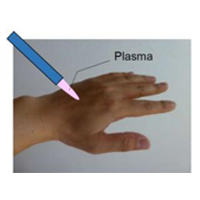
Plasma for medical and biological uses: New electron density diagnostic method
The National Institutes of Natural Sciences, National Institute for Fusion Science and The University of Tokyo Graduate School of Frontier Sciences Department of Advanced Materials Science research group have developed an electron density diagnostic method for atmospheric pressure low-temperature plasma that is anticipated to be applicable for the fields of environmental protection and of medicine and biology. ...
Microwave Imaging: New Image Diagnostic Techniques Born of Fusion Research
“Seeing is believing.” In hospitals, too, observation of lesions through image diagnosis methods such as CT and echo is being conducted. ...
Data Analysis of Waves Inside a Plasma: Cooperating with Basic Plasma Experiments
For the realization of fusion energy, in the plasma experiment devices around the world beginning with the Large Helical Device (LHD) research is being conducted for producing and maintaining high-temperature plasmas. ...
Measuring the Electric Field Structure in a Plasma: Two-Dimensional Electric Potential Diagnostics through the Heavy Ion Beam Probe Method
Plasma is in a state whereby ions possessing a positive electrical charge and electrons possessing a negative electrical charge are scattered. ...
Seeking Materials Stronger at Higher Temperatures: The Development of Oxide Dispersion-Strengthened Metals
In the fusion reactor, we convert the energy from particles generated by the fusion reaction that occurs in a plasma into heat and use that heat for producing energy. ...
Long-Term Prediction of the Temperature and Density of Plasma Made Possible: Computer Simulation Research Focusing on the Butterfly Effect
At the National Institute for Fusion Science, using the Large Helical Device (LHD) we are conducting research in magnetic field confinement of plasma whose temperature exceeds 100,000,000 degrees. ...
Electron Density Diagnostics with a Harmonic Interferometer: Joint Research toward Plasma Applications in Environmental and Medical Fields
Plasma is studied not only for fusion energy, but also for applications in various other fields. In particular, recently, application research in environmental and medical fields has flourished. ...
Using a Coolant Containing Lithium to Remove Heat from Plasma: Developing a Coolant Circulation Loop that Simulates the Fusion Power Generation System
In the future fusion energy generation we will remove heat from high-temperature hydrogen plasma and generate energy through a steam turbine. ...
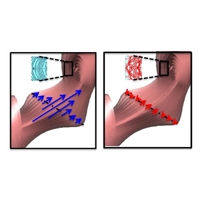
Plasma flow damping observed due to stochastization of the magnetic field
Katsumi Ida and colleagues at the National Institute for Fusion Science (NIFS) of the National Institutes of Natural Sciences (NINS) and Shigeru Inagaki of the Research Institute for Applied Mechanics (RIAM) of Kyushu University in Japan have clarified in experiment how the flow of magnetically confined plasmas is damped when the magnetic flux surface confining the plasma is disturbed (stochastization of the magnetic field). This is the first such observation in plasma for nuclear fusion in the world. ...
Clarifying the Particle Acceleration Mechanism through Shock Waves in a Plasma: Introducing Research Utilizing the Plasma Simulator
Plasma, which is a collection of charge-bearing particles, engages in movements that are extremely varied and complicated. ...
Measuring Negative Hydrogen Ion Density in Plasma: Seeking to Enhance High Performance Negative Ion Sources
In the Large Helical Device (LHD), in order to heat plasma confined by the magnetic field to a high temperature we use a neutral particle beam injection device. ...
Controlling Convection: Numerical Simulation Using Supercomputers
When we raise the temperature of gas, electrons separate from atoms and ions are born, and each ion and electron take on a plasma condition and move about freely. I...
The 18th Plasma Experiment Cycle Concluded: Advances in High-Performance Plasma
The plasma experiments on the Large Helical Device (LHD) conducted during this academic year concluded on February 5, 2015. Since beginning in 1999, this was the eighteenth round of experiments. ...
High-speed Photography of Changes in Plasma: High-speed Soft X-ray Camera Measurements
The Large Helical Device (LHD) confines high-temperature plasmas by making them float in the container that is ringed by magnetic lines of force. ...
New Developments in Research on Steady State Plasma: Maintaining High-performance Plasma for an Extended Period
In the Large Helical Device (LHD), which is able to generate the magnetic field that confines plasma only through superconducting coils, it is possible to maintain high-temperature plasma in a steady state manner. ...
Investigating Periphery Plasma by Inserting a Needle: The Electrostatic Probe Diagnostic
In the Large Helical Device (LHD) a magnetic field container is composed by a helical-shaped electromagnet, and plasma is confined therein. ...
